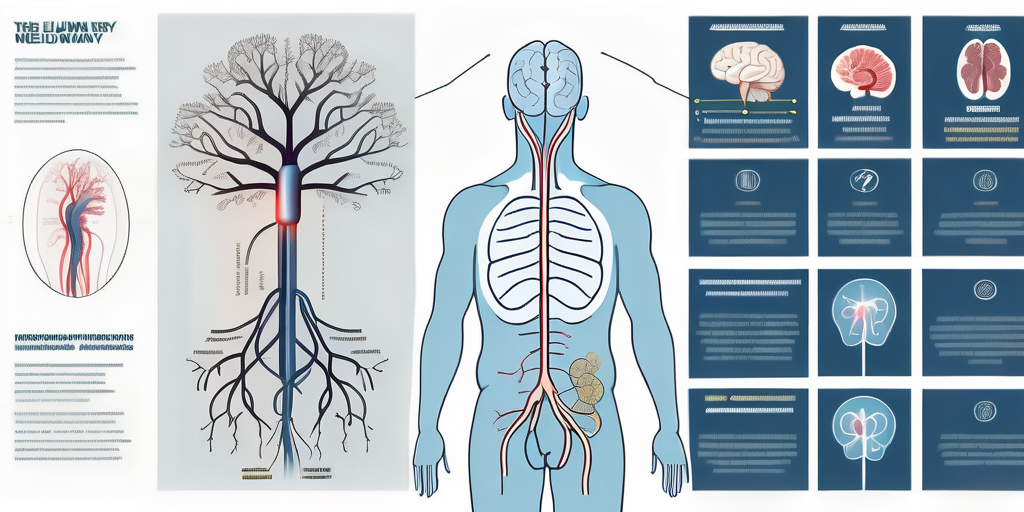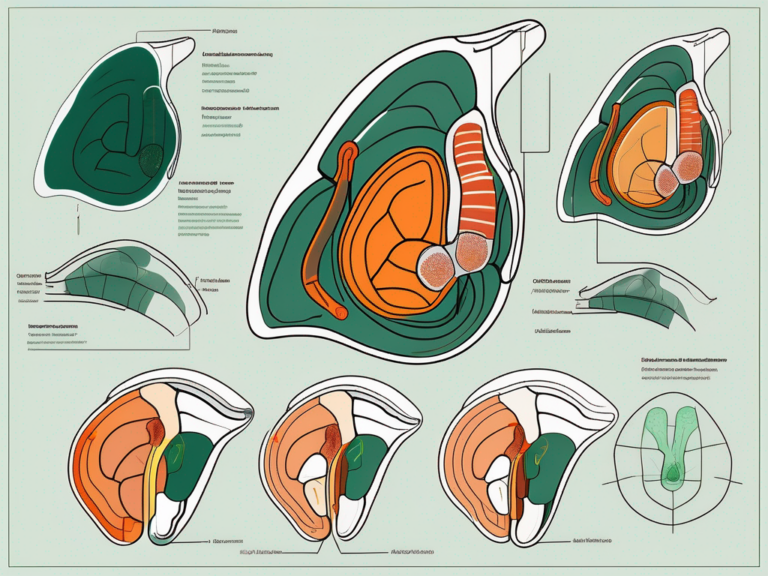vagus meditation
In today’s fast-paced world, finding moments of relaxation and inner peace is more important than ever. One practice that has gained popularity in recent years is vagus meditation. This form of meditation focuses on stimulating the vagus nerve, a key player in our body’s relaxation response. By understanding the role of the vagus nerve and its connection to the brain, we can harness the power of vagus meditation for improved well-being.
Understanding the Vagus Nerve
The vagus nerve, also known as the “wandering nerve,” is the longest cranial nerve in our body. It starts in the brainstem and extends down to various organs, including the heart, lungs, stomach, and intestines. As part of the autonomic nervous system, the vagus nerve plays a crucial role in regulating our body’s involuntary functions.

The Role of the Vagus Nerve in the Body
The vagus nerve is responsible for regulating our heart rate, digestion, respiration, and even inflammation response. It acts as a communication highway between our brain and various organs, transmitting signals both ways. When the vagus nerve is stimulated, it triggers our body’s relaxation response, promoting a state of calm and well-being.
Connection Between the Vagus Nerve and the Brain
Research has shown that the vagus nerve is intimately connected to the brain, particularly the limbic system, which controls our emotions and stress response. When we activate the vagus nerve, we can positively influence our brain’s perception of stress and promote a sense of relaxation and balance.
But did you know that the vagus nerve also plays a role in our immune system? Yes, that’s right! This remarkable nerve has been found to have an impact on our body’s ability to fight off infections and diseases. When the vagus nerve is activated, it releases anti-inflammatory molecules that help reduce inflammation in the body, allowing our immune system to function more effectively.
Furthermore, recent studies have suggested that the vagus nerve may have a role in our social interactions and empathy. It has been found that individuals with stronger vagal tone, which is a measure of the vagus nerve’s activity, tend to have better social skills and are more empathetic towards others. This suggests that the vagus nerve not only influences our physical well-being but also has an impact on our emotional and social well-being.
The Science Behind Vagus Meditation
Vagus meditation, also known as vagus nerve stimulation, is a practice that focuses on activating and strengthening the vagus nerve. By doing so, we can enjoy a wide range of health benefits, both physical and emotional.

The Impact of Meditation on the Vagus Nerve
Studies have shown that regular meditation can increase the activity of the vagus nerve. Through deep breathing, mindfulness, and relaxation techniques, we can activate the vagus nerve and enhance its function. This, in turn, can help us manage stress, reduce anxiety, and improve overall well-being.
Health Benefits of Vagus Meditation
Vagus meditation has been linked to numerous health benefits. By activating the vagus nerve, we can lower blood pressure, improve digestion, boost immunity, and enhance our body’s ability to recover from stress. Additionally, vagus meditation has been found to alleviate symptoms of depression, anxiety, and post-traumatic stress disorder.
Let’s delve deeper into the fascinating world of the vagus nerve and its intricate connection to our well-being. The vagus nerve, also known as the “wandering nerve,” is the longest cranial nerve in our body. It starts in the brainstem and extends all the way down to our abdomen, branching out to various organs along the way.
One of the key functions of the vagus nerve is its role in the parasympathetic nervous system, which is responsible for promoting relaxation and restorative processes in our body. When we activate the vagus nerve through meditation, we stimulate the parasympathetic response, triggering a cascade of beneficial effects.
For instance, vagus meditation has been found to have a profound impact on our cardiovascular system. By activating the vagus nerve, we can lower our heart rate and blood pressure, reducing the strain on our cardiovascular system. This not only promotes heart health but also helps in preventing conditions such as hypertension and heart disease.
Furthermore, the vagus nerve plays a crucial role in our digestive system. When we engage in vagus meditation, we enhance the function of the vagus nerve, leading to improved digestion and nutrient absorption. This can alleviate symptoms of gastrointestinal disorders such as irritable bowel syndrome and promote a healthy gut microbiome.
Another remarkable benefit of vagus meditation is its ability to boost our immune system. The vagus nerve has direct connections to our immune cells, allowing it to modulate immune responses. By activating the vagus nerve, we can enhance the production of anti-inflammatory molecules, strengthen our immune defenses, and reduce the risk of chronic inflammation-related diseases.
As we continue to explore the wonders of vagus meditation, it becomes evident that its effects extend beyond the physical realm. The vagus nerve also has connections to key areas of the brain involved in regulating mood and emotions. By stimulating the vagus nerve, we can increase the release of neurotransmitters such as serotonin and dopamine, which are known to promote feelings of happiness, relaxation, and well-being.
In conclusion, vagus meditation is a powerful practice that harnesses the potential of the vagus nerve to promote holistic well-being. By incorporating this technique into our daily lives, we can tap into a multitude of health benefits, from reducing stress and anxiety to improving cardiovascular health and boosting our immune system. So, why not embark on this journey of self-care and explore the transformative power of vagus meditation?
Techniques of Vagus Meditation
There are various techniques one can practice to stimulate the vagus nerve and experience the benefits of vagus meditation. Two of the most effective techniques are breathing exercises and yoga poses.
The vagus nerve, also known as the “wandering nerve,” is the longest cranial nerve in the body. It plays a crucial role in regulating our body’s relaxation response, heart rate, digestion, and even our immune system. By stimulating the vagus nerve through specific techniques, we can enhance our overall well-being and promote a sense of calm and balance.
Breathing Techniques for Vagus Stimulation
Deep diaphragmatic breathing is a powerful tool for vagus nerve stimulation. By taking slow, deep breaths and focusing on exhaling longer than inhaling, we can activate the relaxation response mediated by the vagus nerve. This technique, also known as “belly breathing,” allows us to fully engage our diaphragm, sending signals to the brain that it’s time to relax and unwind.
Another effective technique is alternate nostril breathing, where we inhale through one nostril and exhale through the other. This practice promotes balance and harmony within the body, as it activates both the left and right hemispheres of the brain. By incorporating this technique into our daily meditation routine, we can enhance our focus, reduce stress, and improve overall cognitive function.
Yoga Poses for Vagus Nerve Stimulation
Yoga, an ancient practice that combines physical postures, breath control, and meditation, offers a multitude of poses that can stimulate the vagus nerve. These poses involve gentle stretching, twisting, and deep breathing, allowing for a holistic approach to vagus nerve stimulation.
Poses such as Child’s Pose, where we kneel down and rest our forehead on the ground while extending our arms forward, can help activate the relaxation response while gently stretching the back and hips. Bridge Pose, where we lie on our back and lift our hips off the ground, not only stimulates the vagus nerve but also strengthens the glutes and lower back muscles. And Corpse Pose, where we lie flat on our back with arms and legs extended, promotes deep relaxation and allows for a complete surrender of the body and mind.
By incorporating these yoga poses into our meditation practice, we can amplify the benefits of vagus meditation. The combination of deep breathing, gentle stretching, and mindful movement helps to release tension, improve flexibility, and create a sense of inner peace. It’s important to listen to our bodies and choose poses that feel comfortable and safe, allowing us to fully experience the benefits of vagus nerve stimulation.
Incorporating Vagus Meditation into Your Routine
Now that we understand the science behind vagus meditation and the techniques involved, let’s explore how to incorporate this practice into our daily routine.
But first, let’s delve deeper into the benefits of vagus meditation. Research has shown that regular practice of vagus meditation can have a profound impact on our overall well-being. It has been found to reduce stress levels, improve mood, enhance immune function, and even promote better digestion. By activating the vagus nerve, this form of meditation helps to stimulate the relaxation response in our body, leading to a state of calm and tranquility.
Best Time for Vagus Meditation
Vagus meditation can be practiced at any time that suits your schedule and preferences. However, many find that starting their day with a few minutes of vagus meditation sets a positive tone for the day ahead. By taking the time to ground yourself and activate the vagus nerve in the morning, you can cultivate a sense of inner peace and resilience that will carry you through the challenges of the day.
Alternatively, practicing vagus meditation before bedtime can help unwind and promote a restful night’s sleep. As you engage in this practice, you allow your body and mind to release any tension or stress accumulated throughout the day, creating the perfect conditions for a deep and rejuvenating slumber.
Overcoming Challenges in Vagus Meditation
Like any form of meditation, vagus meditation can present challenges, particularly in the beginning. It’s essential to be patient with yourself and approach the practice with a non-judgmental mindset. Remember, meditation is a skill that takes time and practice to develop.
If you find it challenging to focus or maintain your breath, consider using guided meditation apps or attending classes to help you establish a regular practice. These resources can provide you with the guidance and support you need to navigate the initial hurdles and deepen your understanding of vagus meditation.
Furthermore, it’s important to create a conducive environment for your vagus meditation practice. Find a quiet and comfortable space where you can sit or lie down without distractions. You may want to dim the lights, light a scented candle, or play soft instrumental music to enhance the calming atmosphere.
Remember, the key to incorporating vagus meditation into your routine is consistency. Start with just a few minutes each day and gradually increase the duration as you become more comfortable. By making this practice a regular part of your life, you can experience the full benefits of vagus meditation and cultivate a deep sense of well-being.
Measuring the Effectiveness of Vagus Meditation
While the benefits of vagus meditation are often subjective and experienced differently by individuals, there are physical signs that indicate the activation of the vagus nerve.

When we engage in vagus meditation, our body undergoes a series of remarkable physiological changes. One of the most noticeable signs of vagus nerve activation is a slower heart rate. As we focus on our breath and enter a state of deep relaxation, our heart rate naturally begins to slow down, creating a sense of calm and tranquility within us.
In addition to a slower heart rate, vagus meditation also leads to deepened breathing. As we consciously take slow, deliberate breaths, our diaphragm expands and contracts, allowing us to take in more oxygen and release more carbon dioxide. This deep breathing not only oxygenates our cells but also stimulates the vagus nerve, triggering a cascade of positive effects throughout our body.
Physical Signs of Vagus Nerve Activation
Increased digestive activity is another physical sign of vagus nerve activation during meditation. When the vagus nerve is stimulated, it sends signals to our digestive system, promoting optimal digestion and absorption of nutrients. This enhanced digestive activity can alleviate symptoms of indigestion, bloating, and even improve nutrient uptake, leading to better overall gut health.
Furthermore, the sense of calm and relaxation experienced during vagus meditation is not just a subjective feeling; it is a tangible physiological response. When the vagus nerve is activated, it releases neurotransmitters such as acetylcholine and gamma-aminobutyric acid (GABA), which have a calming effect on the body and mind. This state of relaxation can help reduce anxiety, lower blood pressure, and improve sleep quality.
Long-term Benefits of Regular Vagus Meditation
With consistent practice, vagus meditation can lead to long-term benefits for our physical and mental well-being. By enhancing vagal tone, the strength and efficiency of the vagus nerve, we can improve our body’s ability to handle stress, reduce inflammation, and promote overall health.
Moreover, regular vagus meditation can foster inner peace and emotional resilience. As we cultivate a deeper connection with our vagus nerve, we become more attuned to our emotions and better equipped to regulate them. This emotional resilience allows us to navigate life’s challenges with grace and equanimity, enhancing our overall quality of life.
Additionally, vagus meditation can bring about an increased sense of connection to ourselves and others. By activating the vagus nerve, we tap into our body’s innate capacity for compassion and empathy. This heightened sense of connection can lead to more fulfilling relationships, improved social interactions, and a greater sense of belonging in the world.
In summary, vagus meditation offers a practical and accessible way to promote relaxation, manage stress, and improve overall well-being. By understanding the role of the vagus nerve and its connection to the brain, we can harness the power of vagus meditation to enhance our physical and mental health.
Whether through breathing techniques, yoga poses, or a combination of both, incorporating vagus meditation into our daily life can bring about profound positive changes. So why not start today and discover the transformative potential of vagus meditation for yourself?






